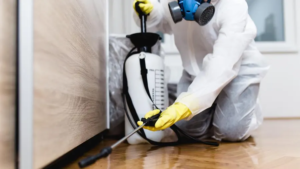Pest control involves preventing or eliminating undesirable organisms, such as insects, weeds, rodents, viruses, nematodes, and disease-causing plants. Natural forces that affect pest populations include climate, natural enemies, natural barriers, and the availability of food, water, and shelter.
Clutter around the house provides hiding places for pests and allows them to access indoor spaces. Caulk all cracks and crevices. Contact a Pest Control Woodland Hills now!

Preventing pests from occurring in the first place is an important part of pest control. This involves eliminating their food, water and shelter sources. For example, in homes and businesses, this means removing garbage regularly and keeping food in tightly closed containers; sealing cracks and crevices; repairing leaky plumbing; and caulking around openings. In agriculture, it includes proper soil management and sanitary practices in handling plants and equipment. Sanitation also helps reduce the carryover of pests from one area to another, such as when transporting crops or harvesting materials.
Pests can be prevented by using cultural, mechanical and chemical methods. Cultivating crops without pesticides, using resistant varieties, and avoiding over-watering are examples of cultural pest control. Pests can be controlled by mechanical means with traps, screens, fences and barriers. Radiation and electricity sometimes are used to alter the environment of pests, such as when controlling flying insects in greenhouses or blocking ants from entering buildings.
Chemical pest controls include sprays, powders, aerosols and baits. They are often used to control invasive species and severe infestations of plant-eating or animal-eating pests, such as rodents, fleas and ticks, in people’s homes and businesses. They can be used on their own or in combination with other methods.
Whether pests are poisonous, disease-causing or simply a nuisance, they all cause harm. The goal of pest control is to limit their numbers and damage to an acceptable level, with as little hazard to other organisms as possible. This balance can be difficult, however, as some organisms are necessary for ecosystem functions.
It’s also important to note that pesticides can contaminate food, pose health risks and cause environmental problems when not handled properly. For this reason, it is vital that building owners, managers and maintenance workers understand pest control and how to use it safely and wisely.
When prevention and suppression don’t work, eradication may be needed to protect the environment and human health. This step is usually reserved for situations where pests are causing unacceptable levels of harm. It is not usually taken lightly, and may require considerable effort to eliminate the entire population.
Suppression
When pests build up to levels that are causing unacceptable harm, they must be controlled. Control methods are often a combination of prevention and suppression, but may also include eradication or even extermination.
Pests can affect our quality of life in many ways, from contaminating food or causing allergic reactions in people to damaging buildings and reducing property values. Rodents and insects can also transmit diseases such as hantavirus pulmonary syndrome, leptospirosis and Salmonella. In addition, pests can cause fear and stress.
A key to successful pest control is knowing when and how to take action. In general, prevention is the best strategy, but if a problem does occur, it’s important to act quickly and decisively.
Step 1: Assess the pest situation. Is it a nuisance pest, like ants or flies? Does it damage crops or other plants? Are the numbers high enough to warrant control? The answers to these questions will determine whether you need to proceed to the next steps.
Step 2: Try to eliminate the pests without using pesticides. This may involve removing food sources, closing off places pests hide or making it harder for them to breed or find water. For example, store food in sealed containers, and keep trash cans tightly closed. Fix leaky plumbing and close cracks and crevices where pests can enter.
Mechanical or physical controls may be used to stop pests from entering the area, including traps, screens, fences and barriers. Chemicals that alter the environment, such as pheromones and juvenile hormones, can also be effective against certain pests. In some cases, introducing natural enemies — parasites, predators and pathogens — can help reduce pest populations. This type of biological control usually is not a long-term solution, however, because there is a time lag between the introduction of new enemy organisms and the effect on pest numbers. Monitoring can be done by trapping or by scouting to look for pest damage and activity. This information can be used to predict when a pest population will reach a threshold level that would indicate the need for control.
Eradication
Eradication is a final stage in pest control and differs from suppression in that it should result in the permanent elimination of an infectious disease (Dowdle 1998; Hopkins 1998) with no recurrence. It requires a global effort involving governments, health organizations, private companies, and individuals. Eradication is viewed as the optimal goal because of the health and economic benefits it creates. These include decreased vaccination costs, avoided future infections, and a “dividend” from the eradication of a disease that consists of the return to normal rates of infection, no new cases from an unforeseen reservoir, or vaccine strain reversion (as currently occurs with yellow fever).
Erradicate, exterminate, extirpate, uproot and destroy all mean to effect complete destruction. The word eradicate originated in the 16th century and comes from the Latin radix, meaning root or uproot. Its figurative application developed as it came to be used of pulling things up by their roots, as in yanking out an undesirable plant or weed from the ground. It is an appropriate word for the last phase of pest control, since it originally referred to removing a pest by killing it or depriving it of its means of reproduction.
Chemical pest control involves poisonous substances called pesticides, which kill or incapacitate pests and other organisms that damage plants or crops. They are also used to kill or control household pests such as ants and roaches, and in medical facilities to eliminate diseases spread by insects, such as malaria, AIDS, dengue, and typhoid fever.
Other chemicals used in pest control are fungicides and herbicides, which help to protect plants and crops by controlling fungus and weeds. They are used in farming to prevent disease in plants and to keep weeds from interfering with crop production.
Some chemical methods of pest control are more extreme than others, such as ultra-low volume fogging, which uses small amounts of pesticide to saturate an area with poison, or fumigation, which seals a building and fills it with gasses, such as carbon dioxide, to quickly kill everything in the building, including people. All chemical pest control methods rely on accurate identification of the target pest. If pests are not identified correctly, they may be in a life cycle stage or location that is resistant to the pesticide, or the wrong pesticide may have been applied.
Integrated Pest Management
In order to keep pest populations at an acceptable level, integrated pest management uses a combination of techniques including monitoring and non-chemical control methods. This helps reduce the risk of exposure to hazardous chemicals and also supports a healthy ecosystem that can better withstand pest outbreaks. Non-chemical controls include physical or mechanical techniques that directly remove pests, block them from entering the environment, or make it unsuitable for their survival. Examples of these methods are traps for rodents, hummingbird feeders for birds, and netting or screens to prevent insects from accessing fruit. Cultural and environmental controls are practices that reduce conditions that lead to pest infestations, such as modifying watering to discourage fungal diseases or avoiding sowing crops at unfavorable times.
Biological controls use natural organisms that eat, parasitize, or otherwise negatively impact target pests. These organisms can be viruses, bacteria, or even nematodes. Bacillus thuringiensis, for instance, is an insect-parasitic bacterium that kills caterpillars. These organisms are often less harmful than synthetic pesticides, and they can be used for many different pest species.
Chemicals are used only as a last resort and only when they are needed to prevent significant damage to the crop. They are applied according to established guidelines that take into account the pest’s life cycle, potential damage, and interactions with other plants and organisms in the area.
When pesticides are used, they are designed to be as targeted as possible. They are formulated with the least amount of toxic materials to avoid harming people, pets, wildlife, and beneficial organisms. They are also incorporated with other non-chemical control methods, so that they are more effective and have lower environmental impacts.
Integrated pest management is not perfect, but it provides the best long-term solution to pest problems and ensures that people and nature can coexist in harmony. The FIPMCC is working to advance IPM as the national standard for pest control. For more information, visit the NIFA FIPMCC website.







